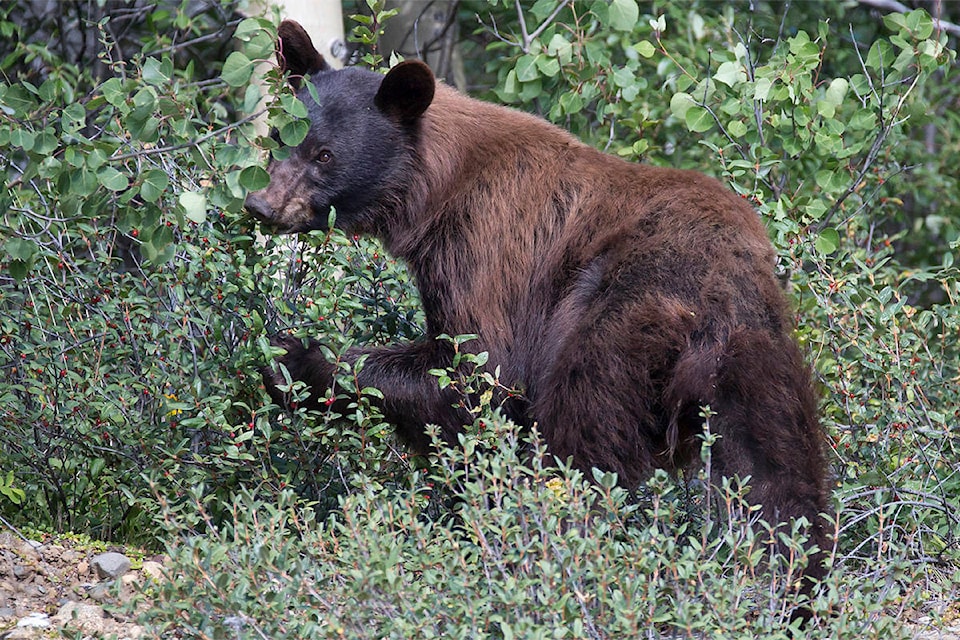An estimated 18 bears were killed between April 1 and July 18 this year, according to data provided by Environment Yukon.
Those are the most recent numbers available for bear deaths this season.
All 18 of the bears were black bears. Eleven were killed by conservation officers (COs) and the remaining seven were killed by members of the public in defence of life or property.
The department only recently released that number in response to an access to information request filed by the News earlier this summer, after Environment Yukon said it would only be releasing bear-death numbers at the end of the season.
In an interview Aug. 10, Environment Yukon’s director of conservation officer services, Gordon Hitchcock, said the department made that decision not because it didn’t want the number released, but because getting it puts too much strain on COs in the midst of a busy season.
Last year, for the first time, Environment Yukon provided regular updates on the number of bears killed that season. The goal was to raise awareness about the consequences of not managing bear attractants like food and garbage correctly, Hitchcock said, but, as the season progressed, the department realized that the amount of work required to get accurate numbers “wasn’t sustainable.”
That’s why Environment Yukon hasn’t been publicly releasing numbers on bear deaths this season.
“We had to struggle and really divert resources (last year),” Hitchcock said. “(It) took a lot of added resources we just couldn’t afford this year.”
Getting rolling bear death numbers is more complicated than it appears on the surface, Hitchcock explained.
The Yukon currently has 20 conservation officers (COs) in the territory (including Hitchcock) who are responsible for 10 districts. Like police officers, when COs respond to a call, they take notes, collect evidence and document what the call was for, how they responded and the outcome.
COs then report back to their district offices, where they upload all that information to an internal database. However, the databases are not searchable and COs upload all their occurrence reports, whether it was a human-bear conflict, a hunting violation or an oil spill, to the same system. That means that, in order to get specific data on a certain type of call, someone at each district has to manually go through all the reports, count them by hand, and then report that information back to headquarters, where the information from all 10 districts is compiled.
The process gets further complicated because COs aren’t always able to upload their information to their district database right away — for example, a CO may be responding to back-to-back calls or be working in a remote location, meaning that they may not get back to the office for days or weeks at a time.
When Environment Yukon started doing rolling bear death numbers last year, Hitchcock said, it introduced a new pressure on COs to upload their reports more often when they were already busy with field work. It also raised concerns that the department would release a to-date bear death number before some COs had the chance to upload their data, meaning that the information given to media and the public was actually wrong.
“The ongoing interest in gathering and verifying numbers throughout the territory wasn’t sustainable.… We were drawing on staff, basically interrupting and we’d have to stop our operations to make sure that that entry stuff was correct, the quality assurance was there, the numbers were right,” he said. “It just interrupted the public service piece of attending to complaints too much that we realized that the priority had to shift to the prevention and the response and that we would look at rolling out those numbers with a report year-end.”
Hitchcock added that COs are a “passionate group” who get “pretty grumpy” when they’re pulled back to do an “administrative function that is viewed as not as (big of) a priority compared to that peak operational period … where officer presence is required out in the field.”
“We focus on prioritizing our workload and prioritizing our workload is, obviously, we attend to the public safety, human health and safety files first and then protection of our environment and wildlife,” Hitchcock said.
While Environment Yukon is working on upgrading to “more efficient systems” to collect and compile CO data, Hitchcock said “currently, our system is a bit cumbersome.” Until that upgrade happens, he added, COs will have to keep prioritizing their tasks, and, at this time of year, that’s on preventing human-bear conflicts and responding to calls.
“One of the big pieces is, folks may never see a bear in their neighbourhood, but little do they know when the lights go out, that there’s bears in the residential interface area and they’re coming in and they’re looking for food sources. And if they get it, they will access it…. It’s just that education piece about how quickly a bear can become conditioned,” he said.
Hitchcock emphasized that killing a bear is “absolutely” a last resort, and something that COs don’t enjoy doing.
“You can see stress and burnout start to creep into staff when they’re basically forced into (euthanizing) bears, in particular, all bears, but sows, cubs and all that, that has some pretty significant impact on staff and we offer some counselling and we have lots of debriefs about it, but it is a duty of the job that is the least liked and the cause of the most anxiety and stress for sure,” he said.
“Our goal, obviously, is prevention, and that means, individually and as a community, doing our part to prevent bears, basically, from accessing human-sourced food attractants.”
Information on how to properly manage bear attractants can be found at www.env.gov.yk.ca/ environment-you/ bearsafety.php.
Contact Jackie Hong at jackie.hong@yukon-news.com
